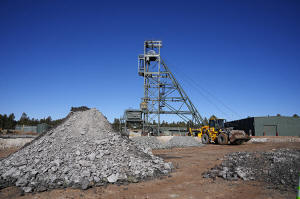Trump fast-tracks Utah uranium mine, but industry revival may wait for
higher prices
[June 02, 2025] By
MEAD GRUVER and HANNAH SCHOENBAUM
SALT LAKE CITY (AP) — In the southeastern Utah desert famous for red
rock arches and canyon labyrinths, the long-dormant uranium mining
industry is looking to revive under President Donald Trump.
Hundreds of abandoned uranium mines dot the West's arid landscapes,
hazardous reminders of the promise and peril of nuclear power during the
Cold War. Now, one mine that the Trump administration fast-tracked for
regulatory approval could reopen for the first time since the 1980s.
Normally it would have taken months, if not years, for the U.S. Bureau
of Land Management to review plans to reopen a project like Anfield
Energy's Velvet-Wood mine 35 miles (56 kilometers) south of Moab. But
the bureau's regulators green-lit the project in just 11 days under a
“national energy emergency” Trump has declared that allows expedited
environmental reviews for energy projects.
More permits and approvals will be needed, plus site work to get the
mine operating again. And the price of uranium would have to rise enough
to make domestic production financially sustainable. If that happens, it
would mean revival — and jobs — to an industry that locally has been
moribund since the Ronald Reagan era.
“President Trump has made it clear that our energy security is national
security," Interior Secretary Doug Burgum said in announcing the
fast-tracking policy in April. “These emergency procedures reflect our
unwavering commitment to protecting both.”
More fast approvals appear likely. Trump's order also applies to oil,
gas, coal, biofuel and hydropower projects — but not renewable energy —
on federal lands.

Condition are ripe for more U.S. uranium mining
Global uranium prices are double what they were at a low point seven
years ago and, for the past year, the U.S. has banned uranium imports
from Russia due to that country's 2022 invasion of Ukraine.
More domestic mining would address a major imbalance. The U.S. imports
about 98% of the uranium it uses to generate 30% of the world's nuclear
energy. More than two-thirds of U.S. imports come from the world's top
three uranium-mining countries: Canada, Australia and Kazakhstan.
Less government regulation won't spur more U.S. uranium mining by
itself. The market matters. And while spot-market prices are up from
several years ago, they're down about a third from their recent high in
early 2024.
While some new uranium mining and processing projects have been
announced, their number falls far short of a surge. That suggests prices
need to rise — and stay there — for a true industry revival, said John
Uhrie, a former uranium executive who now works in the cement industry.
“Until the price goes up dramatically, you’re not going to be able to
actually put these places into operation,” Uhrie said. “You need
significant capital on the ground.”
Still, the industry is showing new life in the Southwest.
Anfield Energy, a Canadian company, also looks to reopen the Shootaring
Canyon uranium mill in southern Utah near Glen Canyon National
Recreation Area. It closed in the early 1980s. A uranium mill turns raw
ore into yellowcake, a powdery substance later processed elsewhere into
nuclear fuel.
Anfield officials did not return messages seeking comment on plans to
reopen the mill and the Velvet-Wood mine.
Energy Fuels, another Canadian company which ranks as the top U.S.
uranium miner, opened the Pinyon Plain mine about 10 miles (16
kilometers) from the Grand Canyon in late 2023.
And just off U.S. 191 in southeastern Utah is a hub of the industry,
Uranium Fuels' White Mesa mill, the country's only uranium mill still in
operation.

[to top of second column] |

A uranium ore pile is the first to be mined at the Energy Fuels Inc.
uranium Pinyon Plain Mine Wednesday, Jan. 31, 2024, near Tusayan,
Ariz. (AP Photo/Ross D. Franklin, File)
 In Moab, uranium has a long — and
mixed — legacy
These days, Moab is a desert tourism hot spot bustling with outdoor
enthusiasts. But the town of 5,200 has a deeper history with
uranium. Nods to Moab's post-World War II mining heyday can been
spotted around town — the Atomic Hair Salon isn't just named for its
blowout hairstyles.
The biggest reminder is the Moab Uranium Mill Tailings Remedial
Action project, a 480-acre (194-hectare) site just outside town. The
decades-long, $1 billion U.S. Department of Energy effort to haul
off toxic tailings that were leaching into the Colorado River
upstream from the Grand Canyon and Lake Mead should wrap up within
five more years.
That mill's polluting legacy makes some Moab residents wary of
restarting uranium mining and processing, especially after the Trump
administration cut short their ability to weigh in on the
Velvet-Wood mine plans.
“This was a process I would have been involved in,” said Sarah
Fields, director of the local group Uranium Watch. “They provided no
opportunity for the public to say, ‘You need to look at this, you
need to look at that.'"
Grand Canyon Trust, a group critical of the Pinyon Plain mine as a
danger to groundwater, points out that the U.S. nuclear industry
isn't at risk of losing access to uranium.
“This is all being done under the assumption there is some energy
emergency and that is just not true,” said Amber Reimondo, the
group's energy director.
Supply and demand will decide uranium mining's future
Hundreds of miles to the north, other nuclear energy projects point
to the U.S. industry's future.
With Bill Gates’ support, TerraPower is building a 345-megawatt
sodium-cooled fast reactor outside Kemmerer in western Wyoming that
could, in theory, meet demand for carbon-free power at lower costs
and with less construction time than conventional reactor units.
Meanwhile, about 40% of uranium mined in the U.S. in 2024 came from
four Wyoming “in-situ” mines that use wells to dissolve uranium in
underground deposits and pump it to the surface without having to
dig big holes or send miners underground. Similar mines in Texas and
Nebraska and stockpiled ore processed at White Mesa accounted for
the rest.
None — as yet — came from mines in Utah.

Powering electric cars and computing technology will require more
electricity in the years ahead. Nuclear power offers a zero-carbon,
round-the-clock option.
Meeting the demand for nuclear fuel domestically is another matter.
With prices higher, almost 700,000 pounds of yellowcake was produced
in the U.S. in 2024 — up more than a dozen-fold from the year before
but still far short of the 32 million pounds imported into the U.S.
Even if mining increases, it's not clear that U.S. capacity to turn
the ore into fuel would keep pace, said Uhrie, the former uranium
mining executive.
"Re-establishing a viable uranium industry from soup to nuts —
meaning from mining through processing to yellow cake production, to
conversion, to enrichment to produce nuclear fuel — remains a huge
lift," Uhrie said.
___
Gruver reported from Cheyenne, Wyoming.
All contents © copyright 2025 Associated Press. All rights reserved |